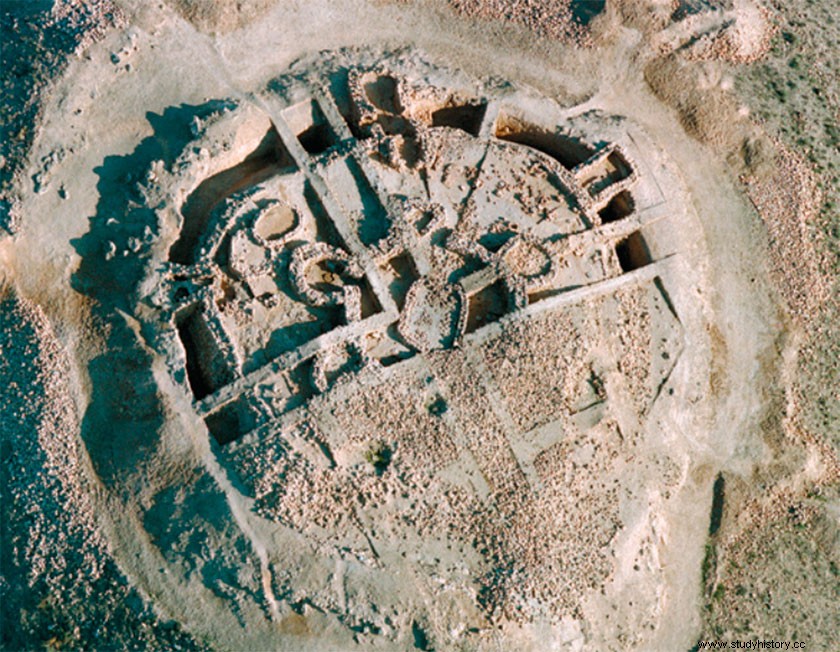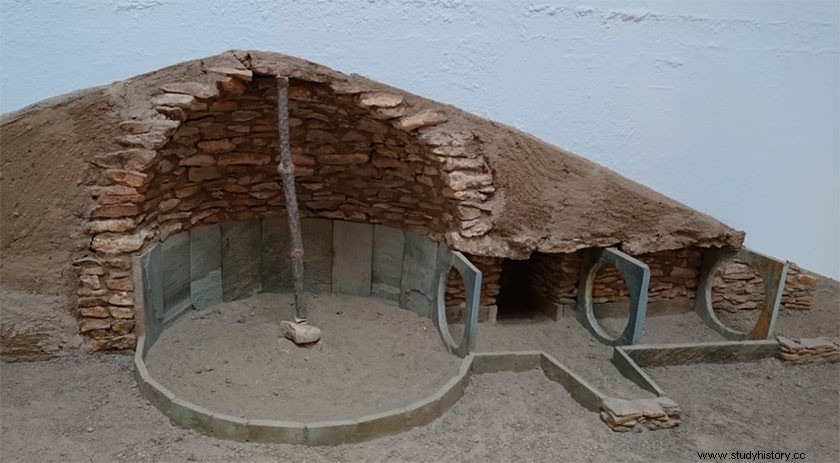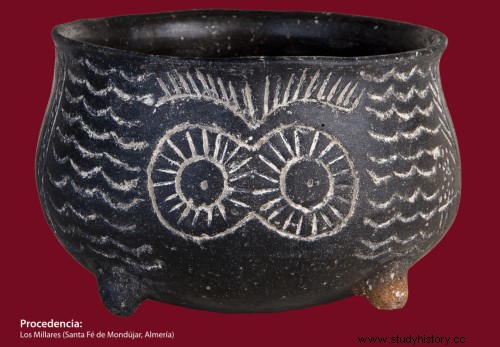
We are heading to Los Millares in the province of Almería , one of the most important archaeological sites in Europe, among those that emerged in the so-called European Chalcolithic, that is, the beginning of the Metal Age. Not only to get to know him a little better, but to try to show how a new hierarchical society was consecrated, which abandoned class equality forever.
The origin of Los Millares.
The town of Los Millares began to be built approximately 5,200 years ago. Since its discovery in 1891, by chance while the railway between Almería and Linares was being built, and until the 1970s. The different hypotheses about its builders looked to the other side of the Mediterranean. In other words, in the same way that three millennia before, human groups had arrived to introduce agriculture and livestock in the Levante peninsular. Now the turn corresponded to miners and merchants who knew the process of making copper pieces. In such a way that Los Millares supposedly became a colony that exported this metal to the eastern Mediterranean.
Today the previous orientalist position It has been refuted by most experts, who join the so-called evolutionary positions. In addition, providing various explanations that reveal the errors of supposed mass arrival of oriental groups. Without going any further, in Los Millares there is evidence of very primitive technology for the production of copper pieces. Someone who ventures to cross the Mediterranean, to exploit a mine, transform the ore, and make copper pieces, does not come without knowing the most advanced techniques. On the other hand, we must think that although some jewels were made, most of the production was destined for daily activities, such as fishing (hooks), or various farming tools. In other words, the main client seems to be native.
Of all the positions, the one that has gained the most followers in recent years was the one exposed by J. J. Eiroa at the beginning of the 21st century. In short, it is a synthesis of the two previous positions. This author does not believe that the genesis of copper metallurgy was in situ, the primitive technology could have been foreign, but possibly carried out by indigenous groups. In other words, ideas traveled more than people, although we can think that 5,000 years ago, they did not travel alone, so some small external group could arrive with said technology and integrate into the Los Millares community.
The new class society.
When approaching this topic we come across contradictions again. Los Millares is considered one of the first towns where different statuses, whether political, economic or social, are openly recognized. The evidence is clear, both in the different sizes of the houses, and in the trousseau of the deceased.
The first hypotheses of this evidence were directed at the arrival of copper metallurgy, that is, said concentration of power was thanks to the control of the production of copper objects. Not only the rich ornaments that accompanied this new high society, but also the farming tools themselves, which favored agricultural improvements, and which were leased in exchange for high commissions.
But evidently this position has been widely contested. The production of copper objects is very insignificant, at least initially. In such a way that most of the production tools were still made with ancient traditions, based on stone carving or polished stone. What produced the class distinction was the control of surpluses, a situation that had been dragged on since the Neolithic, not only agricultural, but also ranchers and miners. It is not necessary to think that Los Millares was a society dedicated to metallurgy, agriculture and livestock was the majority occupation of its inhabitants and therefore the first activities to generate profits.
Ultimately, necessity could have created this class society in Los Millares. Necessity in several senses, a town of more than 1000 people needs agricultural improvements to feed them, without going any further in Los Millares an aqueduct and irrigation ditches were built, as well as walls to protect the surplus. But also the need to control the extraction of minerals, the elaboration of products and even their exchange routes. All this connects with the functionalist theses , that is, control needs institutions that take power. But they also agree with the Marxist theses , all these improvements are aimed at the production of surpluses and wealth, its defense is what provides social division and continuous conflicts. Looking closely, we can deduce that the arrival of social classes was given "by the fish that bites its tail."
A walk through Los Millares to get to know this new society.
As has been exposed, to walk today through the archaeological site of Los Millares, is to walk through one of the most important towns in Western Europe for the understanding of the society of metals . This society not only changed towards the distinction of classes, many other aspects appeared to conform the new way of life of the inhabitants of the Iberian Peninsula.
A new habitat.
The form of the population itself is one of the most important contributions of the Chalcolithic. Its construction in an elevated area overlooking agricultural land, pastures, water sources, and even communication routes, is a novelty. The location of the Poblado de Millares between the Rambla de Húechar and the Andarax river perfectly meets these expectations.
The houses of Los Millares.
As has been pointed out previously, the different status of the inhabitants of Los Millares is recognized by the size of their houses. It is evident that it would not be a general rule, but it would be an indication to take into account, to which we should certainly add the different comforts that it had inside it. Ultimately outwardly they were similar; the classic masonry plinth topped with mud and reeds, with a conical vegetal roof. The latter was supported by a central post and some had a smoke outlet.

Houses of Los Millares associated with the wall
In its interior we found some comforts, such as continuous benches attached to the walls, a central hearth of hardened clay, or a section to place the different homemade ceramics. As well as other elements necessary for the manufacture of textile garments, or to grind wheat.
A well protected village.
The defense of the town, and of course its surpluses, was carried out by building four concentric walls. Those who arrived the Millares found that it was protected by a first wall 4.5 m high, which had to be crossed by a large main gate in the form of a tower, behind which some archers watched over the newcomer. If he was well received, he entered the lower part of the town, where the houses were possibly those of the less fortunate families, next to these houses were some warehouses and improvised stables for the animals.

Recreation of the main entrance of Los Millares
After crossing the second of the walls, a second level of houses was accessed, these already seemed larger, it is evident that they must have belonged to individuals of a higher status than the first level, in addition most of them had homes. In this space there were also a large number of silos where the inhabitants of Los Millares deposited the grain.
Following the path towards the interior of the town they came across the third of the walls, in this case its task was the protection of some public buildings. The first of them could have had great importance in the economy of Los Millares, since it was a kind of workshop for the elaboration of copper products. The production of these could well have been in the hands of the leaders of the city. If not, that may indicate the nearby presence of a kind of palace with warehouses and a central courtyard, without a doubt it must have been the largest building in the town.

Remains of the workshop where copper objects were made.
The last of the walls that this visitor found protected the oldest part of the town of Los Millares, without a doubt the genesis of this new culture. At present we do not know exactly the buildings that were housed there, these were superimposed on each other on various occasions during the more than 1000 years that Los Millares remained inhabited. A large pond stands out that was fed by a ditch that crossed all the previous walls, its mission being the last refuge of the community.
Outside the walls.
It is evident that the entire life of the inhabitants of Los Millares was not carried out within the walls, the cultivated fields, the pasture areas or the river by which they reached the sea, they also needed protection.
More defensive pillboxes.
In the area attached to Los Millares, 13 forts have been counted to date , mostly small circular towers. But what was later called fort 1 was a truly unique protection space. It had a double wall, and on the outside there were at least five watchtowers. Apart from its obvious defensive work, on the one hand it must have been a sacred place, due to the discovery of different idols. On the other, a kind of school of life, since among other activities, the young people of the town began to make arrowheads. Its inhabitants possibly spent long periods staying there, since they had grain and everything necessary for survival.

Aerial view of fort nº 1
Other activities carried out in the vicinity of the town was hunting, despite having domesticated animals, hunting activity was still one of the largest caloric intake. Finally, highlight the miners who extracted copper from the nearby mountains of the Sierra de Gádor, both in the open and even in mine galleries.
The necropolis.
Undoubtedly another of the highlights of this new community, since the dead were deposited outside the village. Specifically through the megalithic construction of the Tholois. Although they were not large, the largest about six meters in diameter, their number is surprising, about 80 have been counted. It is clear to think that they could have been family members, each of the most important families would have a supposedly private one. They were circular in shape and covered with slate, closed at the top with a false dome, as the technique to finish it off was not known, the hole was covered with wood or a large slab, on which they deposited the earth.
As is known, they were reusable spaces, that is, they were continuously open to deposit their relatives. Access was through a long corridor in which various slabs of slate were arranged, these served as doors to protect the place. In some of these tombs, the remains of nearly a hundred people have been located, with the particularity that the children were buried in the same walls, in a kind of small niches. The ochre, or the fire, were unmistakable signs that some kind of farewell ceremony was taking place. Behind it the offerings were deposited, a true marker for the archeology of social differences. In Los Millares, objects have been found that must have come from far away, such as ivory or ostrich eggs.

Vertical section of a tholoi
To focus a little more on the social differences of this new community, note that two of these tholois were located intramural after the construction of the outer wall. It is not unreasonable to think of its leaders.
As a conclusion.
Without a doubt, Los Millares is one of the most paradigmatic places in the Iberian Peninsula to learn about the birth of what anthropology calls “social complexity”. It is evident that they were not alone, especially in the south of the Peninsula, remains of other similar settlements have been located, one of them, Zambujal in Portugal, with surprising similarities in terms of architecture.

Model of Zambujal in Portugal, somewhat smaller but with great similarity
Los Millares was possibly set on fire around the year 2,200 BC. It is significant that in this geographic space in the southeast of the peninsula it was occupied by a new culture, El Argar, where these social differences zoom in a little further, as well as finding the first evidence of warrior aristocracies.
If you want to know more about Los Millares I recommend this article by my friends Esperanza Varo, and Javier Nero from Legionixhispana:Clik on the image


Finally, we invite you to find out the times and conditions of the visit to one of the most essential archaeological sites for the knowledge of our prehistory, on the following website:juntadeandalucia.es
Images:from the Los Millares brochures, commons.wikimedia
